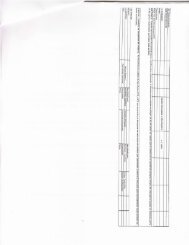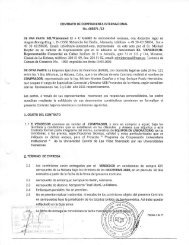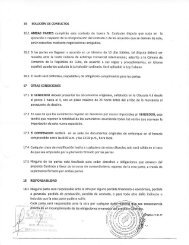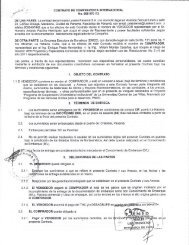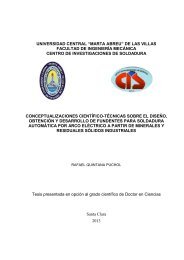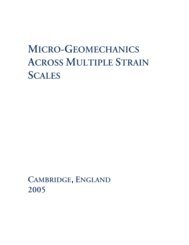Create successful ePaper yourself
Turn your PDF publications into a flip-book with our unique Google optimized e-Paper software.
414<br />
L. J<strong>in</strong>g, J.A. Hudson / International Journal of Rock Mechanics & M<strong>in</strong><strong>in</strong>g Sciences 39 (2002) 409–427<br />
difference between the DEM and cont<strong>in</strong>uum-based<br />
<strong>methods</strong> is that the contact patterns between components<br />
of the system are cont<strong>in</strong>uously chang<strong>in</strong>g with the<br />
deformation process for the former, but are fixed for<br />
the latter.<br />
The most representative explicit DEM <strong>methods</strong> are<br />
the computer codes UDEC and 3DEC for two and<br />
three-dimensional problems <strong>in</strong> <strong>rock</strong> <strong>mechanics</strong> [86–92].<br />
The hybrid technique with dist<strong>in</strong>ct element and boundary<br />
element <strong>methods</strong> was also developed [93] to treat the<br />
effects of the far-field most efficiently for two-dimensional<br />
problems. Similar but different formulations and<br />
numerical codes with the same pr<strong>in</strong>ciples have also been<br />
developed and applied to various problems, such as rigid<br />
block motions [94,95], plate bend<strong>in</strong>g [96], and the blockspr<strong>in</strong>g<br />
model (BSM) [97–99] which is essentially a subset<br />
of the explicit DEM by treat<strong>in</strong>g blocks as rigid bodies.<br />
Due ma<strong>in</strong>ly to its conceptual attraction <strong>in</strong> the explicit<br />
representation of fractures, the dist<strong>in</strong>ct element method<br />
has been enjoy<strong>in</strong>g wide application <strong>in</strong> <strong>rock</strong> eng<strong>in</strong>eer<strong>in</strong>g.<br />
A large quantity of associated publications has been<br />
published, especially <strong>in</strong> conference proceed<strong>in</strong>gs. Some of<br />
the publications are referenced here to show the wide<br />
range of applicability of the <strong>methods</strong>.<br />
* Underground works [100–109].<br />
* Rock dynamics [110,111].<br />
* Nuclear waste repository design and performance<br />
assessment [112–114].<br />
* Reservoir simulations [115].<br />
* Fluid <strong>in</strong>jection [116–118].<br />
* Rock slopes [119].<br />
* Laboratory test simulations and constitutive model<br />
development [120–122].<br />
* Stress-flow coupl<strong>in</strong>g [123,124].<br />
* Hard <strong>rock</strong> re<strong>in</strong>forcement [125].<br />
* Intraplate earthquakes [126].<br />
* Well and borehole stability [127,128].<br />
* Rock permeability characterization [129].<br />
* Acoustic emission <strong>in</strong> <strong>rock</strong> [130].<br />
* Derivation of equivalent properties of fractured <strong>rock</strong>s<br />
[131,132].<br />
A recent book [133] <strong>in</strong>cludes references to a collection of<br />
explicit DEM application papers for various aspects of<br />
<strong>rock</strong> eng<strong>in</strong>eer<strong>in</strong>g.<br />
The sem<strong>in</strong>al DEM work for granular materials for<br />
geo<strong>mechanics</strong> and civil eng<strong>in</strong>eer<strong>in</strong>g application is <strong>in</strong> a<br />
series of papers [134–138]. The development and<br />
applications are mostly reported <strong>in</strong> series of proceed<strong>in</strong>gs<br />
of symposia and conferences, such as <strong>in</strong> [139–140] <strong>in</strong> the<br />
field of geo<strong>mechanics</strong>. The most well-known codes <strong>in</strong><br />
this field are the PFC codes for both two-dimensional<br />
and three-dimensional problems [141], and the DMC<br />
code [142,143]. The method has been widely applied to<br />
many different fields such as soil <strong>mechanics</strong>, the<br />
process<strong>in</strong>g <strong>in</strong>dustry, non-metal material sciences and<br />
defence research. More extensive coverage of this<br />
subject will be given <strong>in</strong> a later expanded version of<br />
this review.<br />
The implicit DEM is represented ma<strong>in</strong>ly by the<br />
discont<strong>in</strong>uous deformation analysis (DDA) approach,<br />
orig<strong>in</strong>ated <strong>in</strong> [144,145], and further developed <strong>in</strong><br />
[146,147] for stress-deformation analysis, and <strong>in</strong><br />
[148,149] for coupled stress-flow problems. Numerous<br />
other extensions and improvements have been implemented<br />
over the years <strong>in</strong> the late 90s, with the bulk of<br />
the publications appear<strong>in</strong>g <strong>in</strong> a series of ICADD<br />
conferences [32–35]. The method uses standard FEM<br />
meshes over blocks and the contacts are treated us<strong>in</strong>g<br />
the penalty method. Similar approaches were also<br />
developed <strong>in</strong> [150–152] us<strong>in</strong>g four-noded blocks as the<br />
standard element, and was called the discrete f<strong>in</strong>ite<br />
element method. Another similar development, called<br />
the comb<strong>in</strong>ed f<strong>in</strong>ite-discrete element method [153–155],<br />
considers not only the block deformation but also<br />
fractur<strong>in</strong>g and fragmentation of the <strong>rock</strong>s. However, <strong>in</strong><br />
terms of development and application, the DDA<br />
approach occupies the front position. DDA has two<br />
advantages over the explicit DEM: relatively larger time<br />
steps; and closed-form <strong>in</strong>tegrations for the stiffness<br />
matrices of elements. An exist<strong>in</strong>g FEM code can also be<br />
readily transformed <strong>in</strong>to a DDA code while reta<strong>in</strong><strong>in</strong>g all<br />
the advantageous features of the FEM.<br />
The DDA method has emerged as an attractive model<br />
for geomechanical problems because its advantages<br />
cannot be replaced by cont<strong>in</strong>uum-based <strong>methods</strong> or by<br />
the explicit DEM formulations. It was also extended to<br />
handle three-dimensional block system analysis [156]<br />
and use of higher order elements [157], plus more<br />
comprehensive representation of the fractures [158]. The<br />
code development has reached a certa<strong>in</strong> level of maturity<br />
with applications focus<strong>in</strong>g ma<strong>in</strong>ly on tunnell<strong>in</strong>g, caverns,<br />
fractur<strong>in</strong>g and fragmentation processes of geological<br />
and structural materials and earthquake effects<br />
[159–165].<br />
Similar to the DEM, but without consider<strong>in</strong>g block<br />
deformation and motion, is the Key Block approach,<br />
<strong>in</strong>itiated <strong>in</strong>dependently by Warburton [166,167] and<br />
Goodman and Shi [168], with a more rigorous<br />
topological treatment of block system geometry <strong>in</strong> the<br />
latter (see also [169,170]). This is a special method for<br />
analysis of stability of <strong>rock</strong> structures dom<strong>in</strong>ated by the<br />
geometrical characteristics of the <strong>rock</strong> blocks and hence<br />
the fracture systems. It does not utilize any stress and<br />
deformation analysis, but identifies the ‘key blocks’ or<br />
‘keystones’, which are formed by <strong>in</strong>tersect<strong>in</strong>g fractures<br />
and excavated free surfaces <strong>in</strong> the <strong>rock</strong> mass which have<br />
the potential for slid<strong>in</strong>g and rotation <strong>in</strong> certa<strong>in</strong> directions.<br />
Key block theory, or simply block theory, and the<br />
associated code development enjoy wide applications <strong>in</strong><br />
<strong>rock</strong> eng<strong>in</strong>eer<strong>in</strong>g, with further development consider<strong>in</strong>g<br />
Monte Carlo simulations and probabilistic predictions



